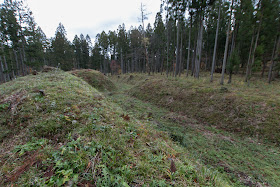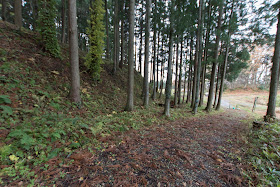Hirabayashi Castle
-Bloody citation-
Overview
Name: Hirabayashi castle (Hirabayashi-jo)
Alias:
Place: Tsuzurayama Murakami city, Niigata
Type: Mountain castle and Hillside residence
Built: 13th century
Remaining remnants: Clay walls and moats
Title:
Brief History
Hirabayashi castle (平林城) is located at the top of Yougaiyama mountain and hillside terrace in Hirabayashi area, which locates at the north part of Niigata plain. Currently there is a vast rice field between the place of the castle and Sea of Japan, but prior to land reclamation in Edo era, there was a large tidal flat at that place, and Hirabayashi area was a easy defensible place surrounded this tidal flat area and Arakawa river.
Origin of Irobe clan and Hirabayashi castle
Historically north part of Niigata plain were held by local large lord named Agakigashu. They were originally magistrates of manors sent from Kamakura Shogunate in 13th century, and gradually grasp their land and turned into local lord. As the governor of Echigo country (Niigata prefecture) located at Jyoetsu area, the south edge of the country, these local lords kept semi independent status from governor.
Hirabayashi area was originally a territory of Hirabayashi clan, and they built Hirabayashi castle as their residence. But in 14th century among the conflict of Emperor Godaigo (1288-1339) and Takauji Ashikaga (1305-1358), the founder of Muromachi Shogunate, Irobe clan defeated Hirabayashi clan and seized this area. Irobe clan which captured Hirabayashi area also used Hirabayashi castle as their residence.
Irobe clan was originally a descendant of Taira clan in Chichibu area (Saitama prefecture), and had the same origin with Honjo clan which was the lord of Murakami castle (Murakami city). Irobe clan gradually grew their power in Muromachi era and became one of the strong lords in this area.
At the beginning of 16th century, Tamekage Nagao (1489-1543), deputy governor of Echigo country and father of Kagetora Nagao (1530-1578, later Kenshin Uesugi), revolted to the governor Fusayoshi Uesugi (1474-1507) and killed him. Irobe clan supported Fusayoshi and Tamekage ordered Nakajyo clan, a neighbor strong lord, to attack Irobe clan at Hirabayashi castle. Irobe clan stand for Hirabayashi castle but finally the castle fell by fire attack, and Irobe clan subordinated to Tamekage.
Bloody Citation
In the middle of 16th century, Katsunaga Irobe (1493-1569) became the leader of Irobe clan. Katsunaga once opposed to Harukage Nagao (1509-1553), governor of Echigo country and son of Tamekage, but when Kagetora succeeded Tamekage, Katsunaga obeyed to this strong leader and supported him as an important retainer.
At the time of fourth battle of Kawanakajima in 1561, Katsunaga activated in the fierce battle and was given a citation called as "Bloddy Citation" by Kenshin. Note that this is not a physical fact but it means this citation was achieved based on the sacrifice of relatives and retainers.
Additionally, during the campaign against Kanto region in 1567, Katsunaga made achievement at the siege of Sano castle (Tochigi prefecture) and got citation again. Katsunaga continuously served as the commander of Sano castle and stand fierce attack from Hojyo clan. Finally Irobe clan became the important retainer of Kenshin, and ranked at seventh among all retainers.
Structure of Hirabayashi castle
At that time Hirabayashi castle was expanded as a residence of important retainer. Hirabayashi castle mainly consist of hillside residence and hilltop fortress. Hillside residence spreads long and narrow height faces a valley. and main residence located the most inside part. The shape of main residence is a pentagon shape affected by terrain, and kept the old shape surrounded by simple clay wall.
In front of the main residence, outer area lays all over the height. These areas might be built or reformed later, and separated by huge clay walls and deep moats. At the slope directly connects to main residence, there was a huge masugata (complex gate), and there were also other several such style gates. The edge of the residence seen from town was guarded by tall slope and deep moat, and it showed authority of Irobe clan to the people.
Hilltop fortress shows old style and might be constructed in old period. The castle area spread at continuous peaks of Yougaiyama mountain at 200 meter height, and mainlyu consist of simply shaped terraces. But there are several large flat areas at the middle of climbing route, and these areas might be added later.
Afterward of castle
After the death of Kenshin, Irobe clan supported Kakegatsu Uesugi (1556-1623) at the internal conflict for successor, and continuously served as an important retainer of Kagekatsu. In 1598 Uesugi clan was transferred to Aizu Wakamatsu castle (Fukushima prefecture) by Toyotomi government, and Irobe clan accompanied this movement. HIrabayashi castle was abolished at that time and closed its history of 400 years.
Now all buildings were lost but shape of the hilltop fortress and hillside residence remain well until now. As Irobe clan was not involved into the battle in the latter half of 16th century, Hirabayashi castle is relatively simple compared with the castles of other major retainers of Uesugi clan. But tall steep wall of front side and huge complex gate surely shows the strength and authority of important retainer of Kenshin.
Access
20 minutes walk from JR East Uetsu-Honsen line Hirabayashi station. 15 minutes drive from Nihonkai-Tohoku Jidoshado Expressway Arakawa-Tainai interchange. 40 minutes walk from hillside entrance to hilltop fortress.
Related Castles
Murakami Castle -Northern fortress-




















































































































































































No comments:
Post a Comment